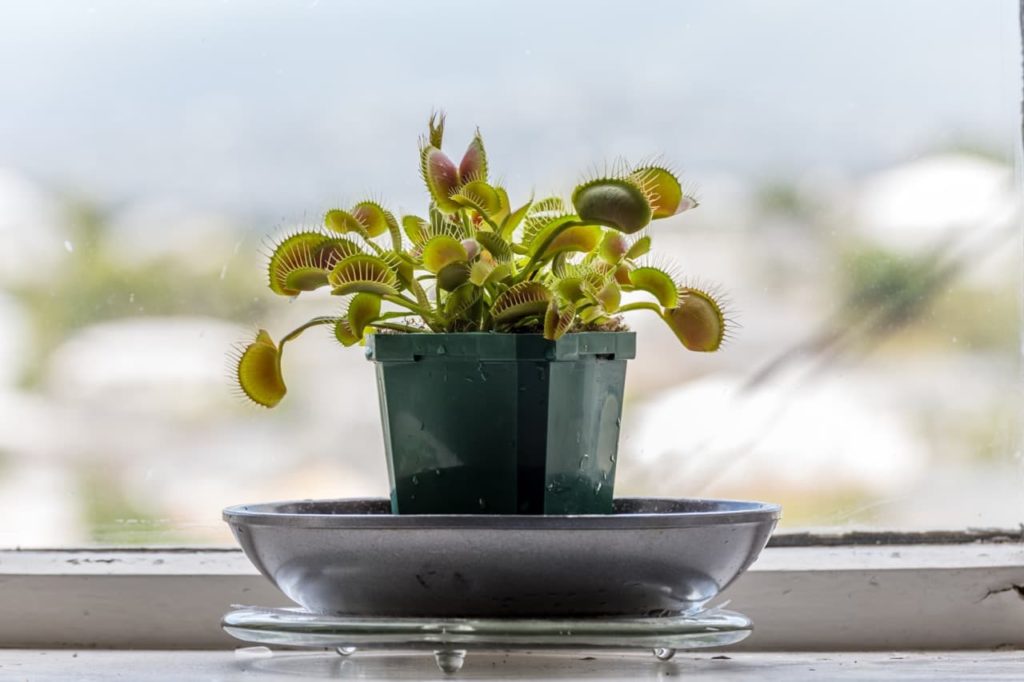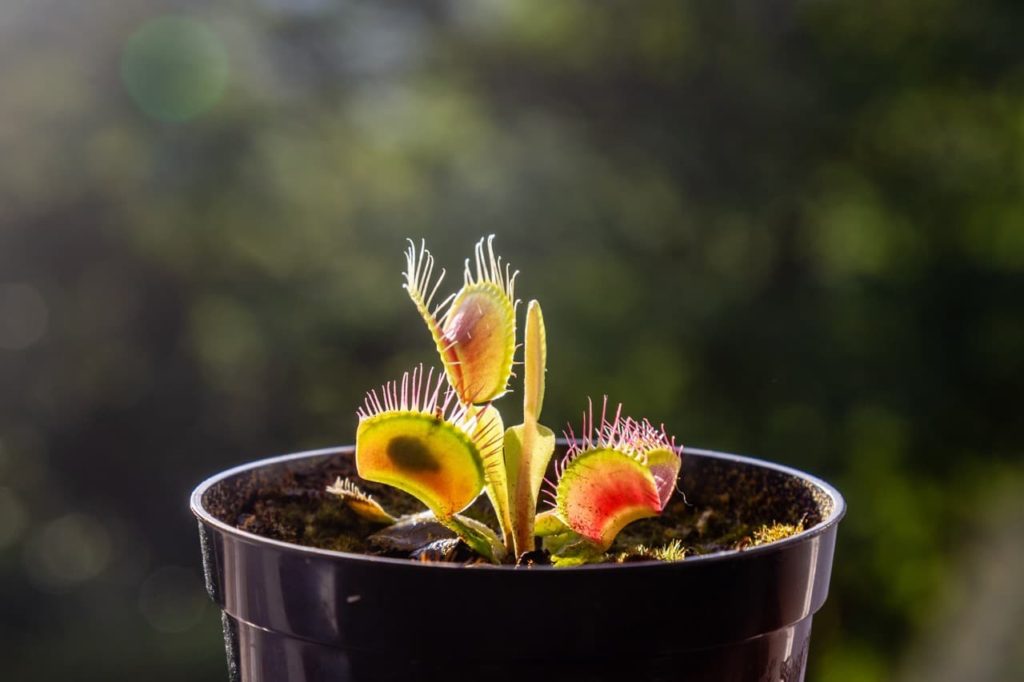Only Feed A Venus Fly Trap During Active Growth Say Experts – These Guidelines Show How

CARNIVOROUS > DIONAEA > FEEDING

Elizabeth is a Permaculture Garden Designer, Sustainability Consultant and Professional Writer, working as an advocate for positive change. She graduated from the University of St. Andrews with an MA in English and Philosophy and obtained a Diploma in Applied Permaculture Design from the Permaculture Association.
Reviewed By PETER LICKORISH

Peter is a Horticulture Lecturer and self-employed Horticulturist, with a passion for diverse areas of the industry - from garden design to the science behind plant growth and propagation. He has completed the Royal Horticultural Society’s Master of Horticulture (MHort) Award and lectures on RHS courses at Bedford College.
Contributions From KENNY COOGAN

Kenny has been growing carnivorous plants for the past 17 years and has experience growing and supplying many different species, including the Venus Fly Trap. He is also the author of the book 'Florida's Carnivorous Plants'.

Kevin has been growing carnivorous plants since 2003 and was actually MACPS’ co-founder, creating the society in 2017. He also exhibits his plants at the Philadelphia Flower Show and has won various awards over the years.

Megan Webb has been growing carnivorous plants for more than 10 years; within that time she has collected a huge number of carnivorous plant genera and species. Megan has a BSc (Hons) in Horticulture from Writtle University College and is the winner of both the Aberconwy Award and the Alan Martin Award.
IN THIS GUIDE
DIONAEA GUIDES
Feeding
Watering
The Venus fly trap, botanically named Dionaea muscipula, is the most popular carnivorous plant to grow as a houseplant in the UK.1Venus Flytrap. (n.d.). National Wildlife Federation. Retrieved April 11, 2023, from https://www.nwf.org/Educational-Resources/Wildlife-Guide/Plants-and-Fungi/Venus-Flytrap
For this guide, we’ve teamed up with two experts in carnivorous plants:
- Kevin Zhang – President of the Mid-Atlantic Carnivorous Plant Society.
- Kenny Coogan – Education Director at the International Carnivorous Plant Society.
Most people are familiar with these fly-eating plants as a novelty often grown within the home.
However, fewer people will truly understand how to care for them correctly and, unfortunately, many Venus fly traps grown as houseplants in the UK do not live for long.
Feeding these plants correctly is one area where people often do not get it right, so in this guide, I will help you understand the basic feeding guidelines and delve a little deeper to understand when and how to feed these fascinating plants.
| Difficulty | Medium |
| Equipment Required | Tweezers, small insects, fertiliser (optional) |
| When To Feed | During active growth (between spring and autumn) |
How Venus Fly Traps Feed In The Wild
Venus fly traps come from the subtropical wetlands of North and South Carolina.2Gonzalez, S. (2022, September 2). The Venus Flytrap: A North Carolina Native. Homegrown: NC State University. Retrieved April 11, 2023, from https://homegrown.extension.ncsu.edu/2022/09/the-venus-flytrap-a-north-carolina-native/#:~:text=The%20Venus%20flytrap%2C%20one%20of,70%2Dmile%20radius%20of%20Wilmington.
In their natural environment, they catch their prey from the environment around them with the trapping structures at the ends of their leaves, which are triggered by tiny, sensitive hairs on their inner surfaces.3Volkov, A. G., Adesina, T., Markin, V. S., & Jovanov, E. (2008). Kinetics and Mechanism of Dionaea muscipula Trap Closing. Plant Physiology, 146(2), 323–324. https://doi.org/10.1104/pp.107.108241
Each plant has between 4-7 leaves arising from a short stem (a bulb-like object) below the ground.

In order for the special traps to shut, two trigger hairs must be touched in rapid succession.4Villazon, L. (2020a, April 15). How do Venus flytraps know when to shut? BBC Science Focus Magazine. https://www.sciencefocus.com/nature/how-do-venus-flytraps-know-when-to-shut/
This is a mechanism designed to ensure that the plant only expends energy on closing when there is worthwhile prey to digest.
It typically takes just 1 to 3 tenths of a second for the trap to shut and once it does, the stiff hair-like protrusions on the edges mesh together and prevent the prey from escaping.5Yang, R., Lenaghan, S. C., Zhang, M., & Xia, L. (2010). A mathematical model on the closing and opening mechanism for venus flytrap. Plant Signaling & Behavior, 5(8), 968–978. https://doi.org/10.4161/psb.5.8.12136
“The mechanisms by which they capture insects are striking,” shares Kevin.

“The Venus flytrap is capable of rapidly snapping its leaves and it is unusual adaptations like this that are what initially drew me to carnivorous plants.”
In our homes, of course, these plants won’t necessarily have access to as many insects as they would in the boggy ground where they naturally belong.
With this in mind, we must consider how we can help them to meet their nutritional requirements when we grow them indoors.
Our aim should be to provide conditions that mimic as closely as possible the conditions in which these plants thrive in the wild and to try to help them feed in as natural a way as possible.
When To Feed Dionaea
When caring for Venus fly traps within your home, you should be aware that you will often have to be responsible for feeding them throughout the period when they are in active growth.
This is usually between spring and autumn.
In autumn, they will die back and remain dormant for the winter months, but they should spring back into active growth once the daylight hours increase the following spring.

You will typically have to feed them in spring and during the summer, as it is unlikely that they will be able to catch enough prey naturally inside a home.
However, these plants can sometimes be placed outside in the summer before they are brought back indoors for the colder part of the year.
If you have adopted this strategy, the plant should be able to catch enough prey on its own in your garden and won’t need any additional feeding throughout this time.
How Frequently Should You Feed Venus Fly Traps?
Through the spring and summer, it is also important to understand how frequently a Venus fly trap will need to be fed in order to receive the sustenance it needs.
This is where many growing these plants inside their homes will go wrong, as they will be tempted to feed far more frequently than is actually required.
A Venus fly trap will only require a meal of a fly or other insect around once a fortnight and it is rarely a good idea to feed more frequently than that.
Feeding once every few weeks will usually be enough to keep your plant healthy and happy.

“The most common misconception is that carnivorous plants will die if they are not fed insects regularly,” says Kevin.
“They can do well without being fed insects for weeks, although if you’re growing them somewhere where there are absolutely no insects, I would recommend feeding something every couple of months or so.”
What To Feed Dionaea
The best things to feed a Venus fly trap are akin to the plant’s wild diet, which largely consists of any insects small enough to fit entirely within one of the traps on the plant, such as different flies, gnats and mosquitoes.
Feeding live prey is preferable where possible.
If you feed dead prey (like pieces of mealworm, for example) then these should be hydrated before they are fed to the plant and you will have to move them a little within the trap to stimulate it to shut.

Fertilisers can also be used, but should not act as a replacement to insects, as Kenny Coogan from the International Carnivorous Plant Society explains:
“In addition to water, one important consideration for growing carnivorous plants is fertilisers.
“Most carnivorous plants have evolved in low-nutrient environments, but random mutations have enabled plants like Venus fly traps to trap prey and have an advantage in these harsher conditions.

“Historically, carnivorous plant growers would say to avoid fertilisers, as they would burn the roots and leaves of plants.
“Recently we learned that some are safe for carnivorous plants.
“If you grow your plants outside and they have access to insects or if you feed them insects, fertilisers are usually not necessary.
“If you are growing them indoors, many genera can benefit from a seaweed-based fertiliser.”
The Feeding Process
To provide your Venus fly trap with a meal, you will have to find and catch a fly or another smallish insect around which a trap on the plant can close completely.
Ideally, it should be smaller than half the size of the trap to prevent decay before the prey is digested.
With a pair of tweezers, take this prey and place it into the trap.
Remember, it is very important not to forcibly close the traps on your plants.
Instead, simply let the trap close on its own.
The trap should close and the process of digestion should begin as long as you let nature take its course.
“Traps re-open after the digestion process, which takes around a week, and can repeat this process a couple of times,” shares Peter Lickorish, a Master Horticulturist.
“You only need to feed one or two traps at once.”

Make sure you do not close the traps or cause them to close without food within because this causes the plant to expend energy unnecessarily, which can lead to problems.
Another key thing to remember is that you should not place foodstuff that is not part of these plants’ natural diets into the traps.
Also, make sure that you do not place anything too large for the plants to handle in there.
When it comes to feeding Venus fly traps, the most important thing of all to remember is that less is more.
References
- 1Venus Flytrap. (n.d.). National Wildlife Federation. Retrieved April 11, 2023, from https://www.nwf.org/Educational-Resources/Wildlife-Guide/Plants-and-Fungi/Venus-Flytrap
- 2Gonzalez, S. (2022, September 2). The Venus Flytrap: A North Carolina Native. Homegrown: NC State University. Retrieved April 11, 2023, from https://homegrown.extension.ncsu.edu/2022/09/the-venus-flytrap-a-north-carolina-native/#:~:text=The%20Venus%20flytrap%2C%20one%20of,70%2Dmile%20radius%20of%20Wilmington.
- 3Volkov, A. G., Adesina, T., Markin, V. S., & Jovanov, E. (2008). Kinetics and Mechanism of Dionaea muscipula Trap Closing. Plant Physiology, 146(2), 323–324. https://doi.org/10.1104/pp.107.108241
- 4Villazon, L. (2020a, April 15). How do Venus flytraps know when to shut? BBC Science Focus Magazine. https://www.sciencefocus.com/nature/how-do-venus-flytraps-know-when-to-shut/
- 5Yang, R., Lenaghan, S. C., Zhang, M., & Xia, L. (2010). A mathematical model on the closing and opening mechanism for venus flytrap. Plant Signaling & Behavior, 5(8), 968–978. https://doi.org/10.4161/psb.5.8.12136
